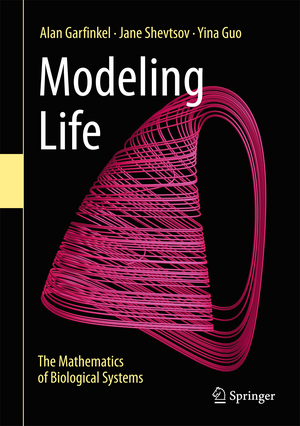Modeling Life: The Mathematics of Biological Systems
Autor Alan Garfinkel, Jane Shevtsov, Yina Guoen Limba Engleză Hardback – 2 oct 2017
Differential equations are the natural mathematical tool for quantifying change, and are the driving force throughout this book. The use of Euler’s method makes nonlinear examples tractable and accessible to a broad spectrum of early-stage undergraduates, thus providing a practical alternative to the procedural approach of a traditional Calculus curriculum. Tools are developed within numerous, relevant examples, with an emphasis on the construction, evaluation, and interpretation of mathematical models throughout. Encountering these concepts in context, students learn not only quantitative techniques, but how to bridge between biological and mathematical ways of thinking. Examples range broadly, exploring the dynamics of neurons and the immune system, through to population dynamics and the Google PageRank algorithm. Each scenario relies only on an interest in the natural world; no biological expertise is assumed of student or instructor. Building on a single prerequisite of Precalculus, the book suits a two-quarter sequence for first or second year undergraduates, and meets the mathematical requirements of medical school entry. The later material provides opportunities for more advanced students in both mathematics and life sciences to revisit theoretical knowledge in a rich, real-world framework. In all cases, the focus is clear: how does the math help us understand the science?
| Toate formatele și edițiile | Preț | Express |
|---|---|---|
| Paperback (1) | 402.50 lei 22-36 zile | +40.69 lei 5-11 zile |
| Springer International Publishing – 14 aug 2018 | 402.50 lei 22-36 zile | +40.69 lei 5-11 zile |
| Hardback (1) | 369.08 lei 22-36 zile | +44.04 lei 5-11 zile |
| Springer International Publishing – 2 oct 2017 | 369.08 lei 22-36 zile | +44.04 lei 5-11 zile |
Preț: 369.08 lei
Preț vechi: 444.66 lei
-17% Nou
Puncte Express: 554
Preț estimativ în valută:
70.65€ • 76.76$ • 59.38£
70.65€ • 76.76$ • 59.38£
Carte disponibilă
Livrare economică 31 martie-14 aprilie
Livrare express 14-20 martie pentru 54.03 lei
Preluare comenzi: 021 569.72.76
Specificații
ISBN-13: 9783319597300
ISBN-10: 3319597302
Pagini: 422
Ilustrații: XV, 445 p. 353 illus., 299 illus. in color.
Dimensiuni: 178 x 254 x 28 mm
Greutate: 1.09 kg
Ediția:2017
Editura: Springer International Publishing
Colecția Springer
Locul publicării:Cham, Switzerland
ISBN-10: 3319597302
Pagini: 422
Ilustrații: XV, 445 p. 353 illus., 299 illus. in color.
Dimensiuni: 178 x 254 x 28 mm
Greutate: 1.09 kg
Ediția:2017
Editura: Springer International Publishing
Colecția Springer
Locul publicării:Cham, Switzerland
Cuprins
1. Modeling, Change, and Simulation.- 2. Derivatives and Integrals.- 3. Equilibrium Behavior.- 4. Non-Equilibrium Dynamics: Oscillation.- 5. Chaos.- 6. Linear Algebra.- 7. Multivariable Systems.- Bibliography.- Index.
Recenzii
“The book can serve as an introduction to the field of modeling not only for university students but for any person interested in the field with little or no knowledge of calculus. … This book is a very interesting deviation from this prevailing paradigm. It takes the essence of calculus and presents it in a way which is accessible and usable in the practice of life sciences professionals.” (Svetoslav Markov, zbMATH 1397.92001, 2018)
Notă biografică
Alan Garfinkel received his undergraduate degree from Cornell in Mathematics and Philosophy,
and a PhD from Harvard in Philosophy and Mathematics. After some years of practicing philosophy of science, Garfinkel transitioned to medical research, applying qualitative dynamics to phenomena in medicine and physiology. Along with James Weiss and Zhilin Qu, he studies cardiac arrhythmias from the point of view of nonlinear dynamics.
Jane Shevtsov earned her BS in Ecology, Behavior and Evolution from UCLA, and her PhD in Ecology from the University of Georgia. Her main research interests lie in mathematical models of food webs and ecosystems.
Yina Guo received her PhD from Nankai University in Control Engineering. Her PhD thesis used partial differential equations to explain the branching structure of the lung. Her computer simulations of branching processes were featured on the cover of the Journal of Physiology. She is particularly interested in the use of graphics and visualization techniques in both research and teaching.
Textul de pe ultima copertă
From predator-prey populations in an ecosystem, to hormone regulation within the body, the natural world abounds in dynamical systems that affect us profoundly. This book develops the mathematical tools essential for students in the life sciences to describe these interacting systems and to understand and predict their behavior. Complex feedback relations and counter-intuitive responses are common in dynamical systems in nature; this book develops the quantitative skills needed to explore these interactions.Differential equations are the natural mathematical tool for quantifying change, and are the driving force throughout this book. The use of Euler’s method makes nonlinear examples tractable and accessible to a broad spectrum of early-stage undergraduates, thus providing a practical alternative to the procedural approach of a traditional Calculus curriculum. Tools are developed within numerous, relevant examples, with an emphasis on the construction, evaluation, and interpretation of mathematical models throughout. Encountering these concepts in context, students learn not only quantitative techniques, but how to bridge between biological and mathematical ways of thinking.Examples range broadly, exploring the dynamics of neurons and the immune system, through to population dynamics and the Google PageRank algorithm. Each scenario relies only on an interest in the natural world; no biological expertise is assumed of student or instructor. Building on a single prerequisite of Precalculus, the book suits a two-quarter sequence for first or second year undergraduates, and meets the mathematical requirements of medical school entry. The later material provides opportunities for more advanced students in both mathematics and life sciences to revisit theoretical knowledge in a rich, real-world framework. In all cases, the focus is clear: how does the math help us understand the science?
Caracteristici
Tackles highly relevant material across the life sciences, using tools best-suited to the field Driven by real-world examples drawn from biology, ecology, medicine, and beyond Builds effective mathematical modeling skills from beginning to end Illustrates every step with engaging, informative graphics in full color Includes supplementary material: sn.pub/extras
